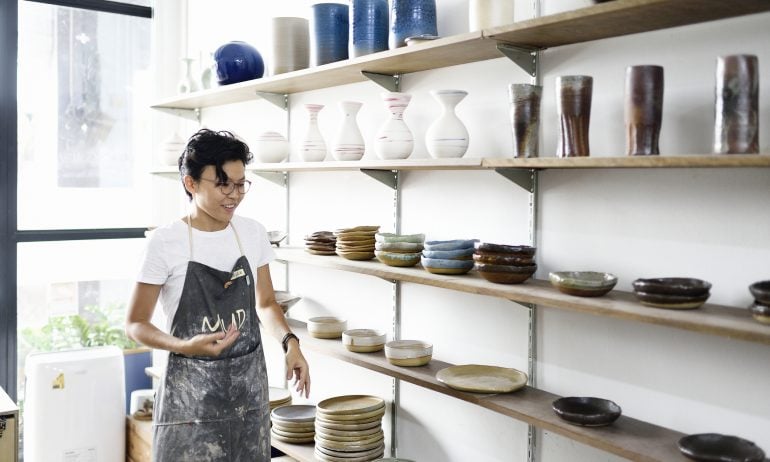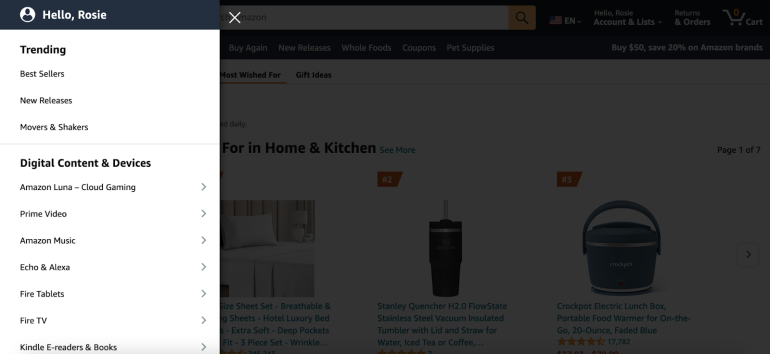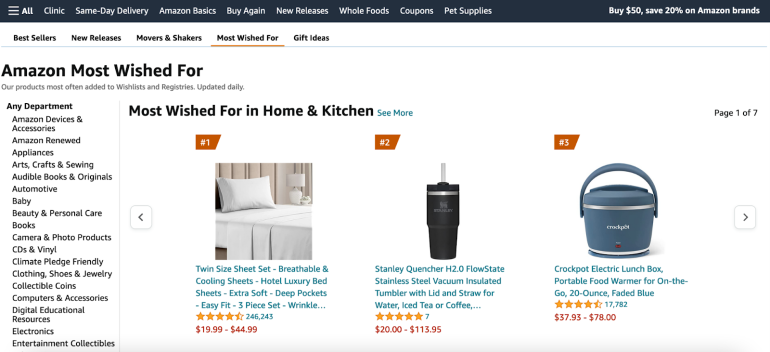How to Find Products to Sell on Amazon

Many or all of the products featured here are from our partners who compensate us. This influences which products we write about and where and how the product appears on a page. However, this does not influence our evaluations. Our opinions are our own. Here is a list of our partners and here's how we make money.
To find products to sell on Amazon, you need to decide what you want to sell, then source the items from a wholesaler or manufacturer. These steps require market research, an understanding of Amazon’s tools and clear-eyed evaluations of your potential profit.
Here’s how your e-commerce business can find products to sell on Amazon.
FEATURED
1. Find the right products to sell on Amazon
Some Amazon businesses start out knowing exactly what they want to sell. Others focus on what’s hot on the platform and try to seek out those products.
Ultimately, the right products to sell on Amazon are the ones that make sense for your business. To help you determine that, establish some general criteria before looking at specific items.
Here are ways to evaluate potential Amazon products overall:
Product cost: How much does the product typically cost to manufacture or buy wholesale?
Sale price: How much do products like this tend to sell for on Amazon? Is there enough margin between your cost, Amazon’s transaction fees and the sale price to generate a profit?
Shipping challenges: Are these products easy to ship, or will you need specialty fulfillment support? If you’re dropshipping, are you abiding by Amazon’s rules?
Competition: Who are the other players in this space? Will you be able to compete with them on quality and price?
Customers: Who is the ideal customer for the product you're looking to sell? Will you need to reach them on Amazon, or should you invest in other online marketing strategies to help develop your brand?
FEATURED
2. Research products to sell on Amazon
Once you have a sense of how things like cost and fulfillment will influence what you sell, you can find items that fit the bill. Here’s how to evaluate product ideas and discover new ones.
Think like your customer
If you want to explore opportunities and competition within a certain category, head to Amazon, type in a search term and choose “Sort By: Best Sellers.”
Choose a specific item and look in the “Product Information” section for details about its popularity. Amazon shares things like like:
The Amazon Best Seller Rank, which shows how popular the item is compared to others in that category.
How long that product listing has been live.
How many reviews customers have left and what the average star rating is.
It’s not an exact market analysis, but looking at listings in your category can be a good first step toward understanding the landscape you’ll be competing in.
Use Amazon’s tools
You can survey Amazon’s market landscape in several other places on the platform, including:
Hot New Releases: These items were recently listed on Amazon and are already bestsellers. Choose “New Releases” from the navigation menu to view.
Movers and Shakers: These are products quickly gaining popularity in their given categories. Located right below “New Releases” in the navigation menu.

Most Wished For: Once you’re looking at Hot New Releases, you can toggle to “Most Wished For” and “Gift Ideas” in the secondary navigation bar. “Most Wished For” items are often added to users’ wishlists and wedding and baby registries.
Gift Ideas: These items are the ones most commonly ordered as gifts.

Product Opportunity Explorer: This tool is available in Amazon Seller Central. You can use Product Opportunity Explorer to see how many users are searching Amazon for certain keywords, then dive deeper in each category to identify trends in customer reviews, see out-of-stock rates and understand how many sales use Prime shipping or pay for sponsored placements.
Use third-party tools
You can also use other platforms to gauge interest in certain items. Google Trends, for instance, can give you a sense of the popularity of a given search query and whether that interest is growing or waning.
Next, explore other marketplaces like eBay, Etsy, Alibaba and Aliexpress. Your customers may be looking at these platforms too, and seeing what’s popular there — and how much it’s selling for — may help deepen your understanding of the market.
Last, you can turn to third-party product research tools like AMZScout and JungleScout. These services can help you research keywords, browse databases for top-selling products that meet your criteria, seek out product suppliers and compare your prices to those of other sellers. These tools typically aren’t free, however.
3. Decide how and where to source your products
Here are different ways to stock your Amazon store, whatever your online business idea might be.
Retail arbitrage
Best for: Startup sellers testing the Amazon sales waters, plus those who aren’t attached to selling one particular type of good.
In retail arbitrage, you purchase deeply discounted retail products and resell them on Amazon. It sounds simple, but making a profit takes some work.
The secret is knowing what’s selling well on Amazon on any given day and for how much. You also need to clearly understand your transaction costs: Amazon charges a referral fee for each item sold on the platform, which can range from 8% to 45% of the sales price depending on what you’re selling.
To spot profitable bargains, you can use the Amazon Seller app or a third-party Amazon pricing app, which lets you scan item UPC codes and match them to current listings for that product on Amazon. These apps can then share information to help you price retail arbitrage products, like the average selling price and potential shipping costs.
You can then use that information to decide whether to buy a product, and if so, how much inventory to stock.
Retail arbitrage is one way to dip your toe into Amazon selling, since your biggest investment will be buying discounted goods. However, it can be hard to build a consistent business since you’re always chasing different products. Plus, you need a good grasp of consumer demand cycles so you don’t overbuy goods fading in popularity, like kids’ backpacks when the back-to-school rush is over.
Dropshipping
Best for: Sellers that don’t want to keep goods in stock themselves.
Dropshipping is an e-commerce business model in which you don’t actually handle inventory yourself. Instead, you source products from third-party sellers off-site. Then, you list those products in your Amazon store.
When customers make a purchase, you pass that order along to your supplier, who ships the product directly to the customer.
Amazon has specific rules for dropshipping. These include:
The receipt the customer receives has to show your company as the seller, not the manufacturer or dropshipping supplier.
You have to remove any packaging or labels with the original supplier’s name.
You, not the manufacturer or supplier, must handle returns.
Print-on-demand services
Best for: Designers, artists or anyone with ideas for custom-printed goods that can help spread the word about their brand.
Print-on-demand (POD) is a form of dropshipping in which a customer orders a piece of merchandise — like a mug, poster or T-shirt — and then the POD supplier prints the seller’s design onto that piece of merchandise and ships it to the customer.
You need two things for print-on-demand selling with Amazon. The first is digital artwork. The second is an account with Amazon Merch on Demand.
Amazon POD sellers upload their designs to Amazon Merch on Demand. The number of designs is capped at 10, 25, 100 or 500 based on sales history and Amazon’s discretion. Then, they can choose to offer T-shirts, tank tops, sweatshirts, smartphone cases, pop sockets, tote bags and throw pillows.
When buyers order these products, they’re presented with their usual Amazon shipping options — Prime shipping for members, other options for nonmembers.
Your royalties are based on your sales price minus Amazon’s costs. For a T-shirt that costs $15.99, Amazon says you can expect to keep $1.93. If the shirt costs $25.99, you’ll keep around $9.32.
Print-on-demand sales come with few startup costs, though you’ll have to pay for an Amazon Seller account. If you’re seeking to sell merch associated with your brand, shop around: Other e-commerce platforms like Shopify and Squarespace offer cheaper ways to do so.
Wholesaling
Best for: Sellers who want to offer a variety of products but not manufacture them.
Wholesaling is another way to find cheap products to sell on Amazon. But unlike retail arbitrage, it’s easier to develop a niche. You can visit trade shows and buyers’ markets within your industry to find wholesale vendors, or you can search online.
When you work with wholesale suppliers, you purchase goods in bulk. You’ll have to figure out how to store your inventory and ship products as they’re ordered. You can handle product storage, order packing, and shipping yourself, or use Fulfillment by Amazon (FBA) as an e-commerce fulfillment center.
However you fill orders, you’ll likely need to track your inventory levels so you can refill stock or discontinue items as needed. Many inventory management software programs can integrate with your Amazon Seller and FBA accounts.
As a wholesaler, you can order small quantities at first to test the market for a given item. With wholesale pricing, the more you buy, the cheaper each item becomes — so you might not earn much profit on these initial sales. Once you find an item that wows customers, you can order larger amounts.
Direct sourcing
Best for: Established sellers who want to create unique branded products.
With direct sourcing, you purchase goods right from the manufacturer. You may be able to purchase direct-source stock products, meaning products that the factory already makes, at lower per-unit costs than wholesale prices. You can also have custom goods made to order so you offer truly unique items.
You can find direct-source factories through trade shows or online research. As you develop relationships with wholesale suppliers, you may learn that some operate their own factories and can help develop products for your company.
Like wholesale product sourcing, direct sourcing requires keeping a careful eye on product costs and inventory levels. You’ll also have to decide whether to handle warehousing, packaging and shipping yourself or pay FBA to handle it.
Inventory management software that integrates with your Amazon Seller and FBA accounts, plus any other storage facilities, is critical for most direct-source sellers. This lets you track stock in different locations and see when it needs to be replenished to ensure orders ship on time.
Direct sourcing can be difficult, since you’ll need to develop relationships with suppliers and invest in product development. You may want to invest in your own e-commerce website to further distinguish your brand. But it also offers you the chance to design and craft products to your own specifications, rather than making do with what you find on the market.
Private labeling or white labeling
Best for: Sellers wanting to build a branded collection on a budget.
Private labeling is similar to direct sourcing in that you source goods directly from manufacturers. But in this case, suppliers manufacture generic goods, then label, tag or package them under your brand.
You can find private label products in virtually any product category, from personal care items and cosmetics to kitchen tools, pet supplies, gourmet foods and much more.
The process of finding private label products to sell on Amazon is similar to finding wholesale and direct-source suppliers. Some manufacturers offer a private label option on their stock goods, or you can find private label vendors within a specific product category using a quick online search.
As with wholesaling and direct sourcing, you have to buy in minimum quantities, then stock and ship products to your customers — either on your own or with Fulfillment by Amazon. And you’ll need to track inventory, restock products and continually develop new ones.
Private labeling may be a good choice for businesses that want to expand their offerings but don’t have the expertise or resources to develop new products from scratch.
Making items yourself
Best for: Artisans and creatives making their own products by hand.
You have to apply to sell on Amazon’s Handmade section. You can start listing products once Amazon approves you.
While you have to sign up for an Amazon Seller account to apply for Handmade, Amazon says it waives the $39.99 monthly fee for approved Handmade stores after their first month. But Amazon charges a 15% referral fee for Handmade sales, which is about 5% more than the total cost of selling in an Etsy shop.
The cost of crafting handmade goods depends on what raw materials and tools you need and what products you create, so production costs can vary widely. But by selling on Amazon, you’ll have the option to choose FBA for stock storage, order packing, and shipping instead of handling everything yourself.
A version of this article originally appeared on JustBusiness, a subsidiary of NerdWallet.




